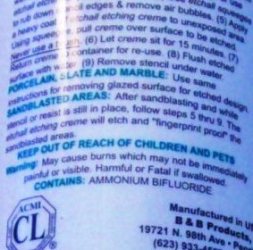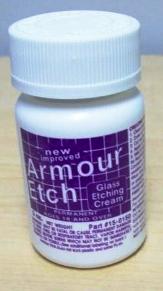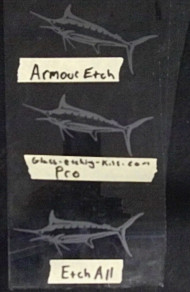I recently changed one of my pages due to inaccurate information and also someone previously sent me an email asking how to make it as shown below:
“Hi Mr Eric. I saw your web page, and I need to learn how to make the cream formula. I know one of the chemical ingredients is HF, but I want to know in more detail what other materials are needed to mix until it becomes cream. That way the image looks more like ice snow.
Can you inform me?
Thank you for your attention and I hope to hear from you soon.”
I thought you should be aware of this as well, and you may have a similar question. See my answer below:
My page was actually incorrect before about the typical cream containing HF. Someone previously contacted me about it and I changed the site thanks to LeeAnn Higgins of the University of Minnesota Department of Biochemistry.
Although HF can be used for etching, it is very dangerous, and I don’t recommend using it. I have not seen any other brand use HF as an ingredient, but I haven’t researched all of them enough since I mainly use sandblasting techniques. The Armour Etch brand does not have any hydrofluoric acid in it as my page mistakenly stated before. You can see the MSD sheet here. The chemicals that make up the Armour Etch cream are:
- Barium Sulfate
- Sulfuric Acid
- Sodium Bifluoride
- and Ammonium Bifluoride
I hope this helps and if you have any other questions let me know.
Share this on social media or email by clicking below!

 “Hi Mr Eric. I saw your web page, and I need to learn how to make the cream formula. I know one of the chemical ingredients is HF, but I want to know in more detail what other materials are needed to mix until it becomes cream. That way the image looks more like ice snow.
“Hi Mr Eric. I saw your web page, and I need to learn how to make the cream formula. I know one of the chemical ingredients is HF, but I want to know in more detail what other materials are needed to mix until it becomes cream. That way the image looks more like ice snow.


Barium Sulfate
Sulfuric Acid
Sodium Bifluoride
and Ammonium Bifluoride
out of all which will be the best for the etching car glasses?
for creating paste base should be Plaster of Paris or any other solid so that paste temains stationary on verticle glass for 20 minutes ?
Dear Mr. Eric,
I am glad to know the 4 ingredients of glass etching cream by your article. I would be very pleased if you could mention the quantity of each ingredient to make a perfect mixture of that cream.
Best Regards,
Zahid
Hi Eric,
I am using the etching cream to fabricate the nanochannels,but the etching rate is too fast, so I have to dilute the cream to slow down the etching speed.I tried the water, but it is not good enough because I found some sediments after standing it for a while,can you give me some suggestions to dilute it?
Thank you very much.
Feng
Hi Eric. I live in South Africa, and am not able to find glass etching cream. I teach craft classes, and a few years back I was able to get the cream from a supplier who now no longer exists. Because of the chemicals involved – I am also not able to order the ready made cream from the USA – as they do not ship to outside of the USA. I would love to be able to make my own – or get a qualified person to mix for me here – and so I would like to know the quantities for the ingredients please. Many thanks Kind Regards,
Sherine
Hi Eric, Could you elaborate the best chemical for the making of glass etching cream. This is not heard of in Sri Lanka. I would appreciate if you could help me to find this out.
Charles
Chinese products i don’t trust.
The American Armour etch doesn’t get sent outside the USA too often by online stores.
I’m into arts & crafts for weddings.
Kindly, assist me with the quantity used to produce etching cream? if need be I can get a chemist to mix it for me. . HF is to dangerous to attempt using. Kindly assist.
Philip W Bitrus
Hi Eric
as I live in Namibia and cannot import etching creme, I have to have it made at a local chemical lab.
could you perhaps tell me what the ratio of the mix is so I can notify the lab.
Your assistance will be greatly appreciated.
regards
Estelle
Hi Sir pls tell how many qunanty mix for cream made glass etching and how and repair if wrong print
Regards
Lalit
thank for recipe
but need more clarificaton about % of each
Barium Sulfate
Sulfuric Acid
Sodium Bifluoride
and Ammonium Bifluoride
thanks again
if we use hudrofloric acid HF carefully by making cream with MEK is it possible . I it will work
Hi there, I also live in Namibia and used to work with the etching cream a lot. Unfortunately I also cannot get hold of it anywhere anymore and would like to ask a lab to mix it for me.
Could you please help me with the correct quantities.
Kind regards
Mausi
We can’t get the Armour Etch here in South Africa and I want to make frosted glasses for my wedding gifts. All I could find was “Etching Fluid” but it keeps flowing underneath my stensils so I need to make a thicker solution of this acidic fluid. I already tried wood glue (goes all rubbery) and hand cream – goes fluid. I need to know how to make the acidic fluid into a more cream-like texture, any ideas?
@Gerda, I honestly haven’t tested thickening agents, but you could try Gel Medium (http://amzn.to/29WPqHR), Hydroxyethyl Cellulose (http://amzn.to/2ahIgOe), Tragacanth Gum, Microcrystalline Cellulose, and Carboxymethyl Cellulose. Corn starch and flour might even work.
Hi Eric, I am going to re-open this whole process, as we are going to play around with the mixture, then we should once again be able to supply the product in South Africa. I have access to the ingredients as well as thickeners, so will keep you updated on the results achieved.
dear plz mention the quantiy of all these chemicals
how much percentage or ml/mg use for one once(30 grams) cream
thanks
for one oz cream (30 grams approx)
percentage is this
5 grams barium sulfate
3.3 ml sulfuric acid
2.5 grams sodium bi fluoride
1.5 grams ammonium bi-fluoride
@raheil g khan you tried the 30g composition that you wrote? its only curiosity.
Hi, we can make glass etching cream much better than the popular brand because our cream costs much less & etches glasses in 30 seconds only. Our problem is how to market the same globally. We welcome any assistance anybody can give us financially and technologically.
Please google “how to etch glasses in 30 seconds” or “etch glasses in 30 seconds” for procedures. Thanks.
Hi Eric, I know how to make glass etching cream which etches glasses in 30 seconds only. The etch is comparable to Armour Etch. My problem is how to market it and make some money to pay all my debts. My product’s name us DEVOUR ETCH FA. Please google “etch glasses in 30 seconds youtube” for demo and comment on it if you may. Thank you very much.
To raheil g khan
For one oz cream (30 grams approx)
percentage is this
5 grams barium sulfate
3.3 ml sulfuric acid
2.5 grams sodium bi fluoride
1.5 grams ammonium bi-fluoride
My question is
Is this formulation in gms or percentage.
Plz reply
Thanks
ummmmmmmm what are the concentrations and amounts my dude?
If Waseem’s amounts are correct, math will solve that. A ml of liquid weights about a gram so:
17% barium sulfate
11% sulfuric acid
8% sodium bi fluoride
5% ammonium bi-fluoride
Thanksss Mr. Eric ur a real pal 😉
Muy buena info.pero averigüen si en bifloruro amonio contiene %de ácido fluorhídrico.gracias por ser tan amigables
i want to know equvalent of those element
In the formula mentioned above to make an etching compound, what is the molarity / strength of the sulfuric acid?
Eric,
we are using this to remove a coating. Think what is really working as the agent for us on the coating is the ammonium bi-fluoride.
how would I make that into a paste ( we bought some of the crystal form of ammonium bi-fluoride)?
For the person that said that there fluid flows under their stencil maybe they should put the fluid in a spray bottle